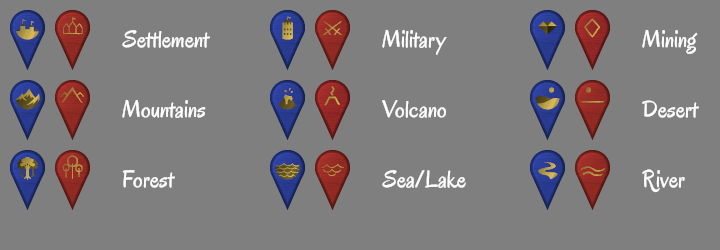Nalanmar
A major port city on the border between Vélypholis and Ronochis.
Demographics
Nalanmar is inhabited by a colorful mix of citizens from various Nimýric kingdoms. The majority of families have both Vélypholic and Ronochic roots, but the port city also attracts countless people from all over the Nimýric Empire. It is also a very rich city, thriving on trade and scientific research.
Industry & Trade
The Nalényó River and the Davygómara Ocean play a major role in distributing goods within the Nimýric Empire. As such, trade is at the heart of Nalanmar's economy.
Some of the most important goods are:
- naléra roots, a popular spice harvested on the river banks
- Rophnýnic marble, a prestigous building material
- ligytara nuts for use in medicine
- bygara pits, the main ingredient of bygeó
- iron and other metals from the two mountain ranges which encapsulate the southern kingdoms
- sophisticated machinery like clocks, typewriters or radio devices
- roctó fabric, made from the fibrous seed capsules of a regional tree species
- books on various scientific topics
Districts
The Eastern Port
The oldest and most striking part of Nalanmar is the seaside port. This is where all the trade goods from the southern kingdoms are sorted, loaded onto massive cargo ships and sent on their way to the rest of the Empire. Countless docks and wharfs sit on the shoreline, and broad roads lead away to the warehouses behind them.The University District
In addition to its port, the city prides itself on a prestigious university. Apart from the University of Nimýrolynn, it has the most comprehensive library in the whole Empire and is among the driving forces of scientific progress in this civilization. Several museums of history and fine arts are found in the neighborhood, as are large housing complexes for the scholars who either live here permanently or come from far away to gain new insights.The Palace District
An impressive palace in the southwest houses the royal family of Ronochis. It was built centuries before the age of Nimýron the Benevolent and makes heavy use of the famous Rophnýnic marble. The majority of the city's nobility resides in the surrounding area. This is where shops and market sell the most expensive delicacies, the latest fashion in clothing and the most refined artworks.Dependent Towns
A number of towns, mostly along the coast and the western outskirts, count as parts of Nalanmar for administrative purposes and in everyday conversation. They usually carry compound names which associate them with the port city. The most famous one is Lutédólin de Nalanmar, the town where the legendary "Demon of Nalanmar" is said to have been encountered.History
Ancient Heritage
Nalanmar has existed at least since the year 760 NN. It was already a hub of civilization when Nimýron the Benevolent forged an alliance with the Vélyphola clan. After his youngest son, Malórin ti Epunda, lead a major expedition far into the southern forests, Nalanmar became crucial for establishing trade relationships with the people living there.The Demon of Nalanmar
In the spring of 1083 PN, rumors spread that Lutédólin, a coastal town south of Nalanmar, had made an unusal prisoner. A trio of fishermen claimed that they had spotted a hideous, twisted monster on the beach as a massive tidal wave was approaching. According to them, the unholy creature walked like an Ichtýd but looked almost nothing like one, and it was bending the light of the Kaleidoscope itself in order to command the water. Desperate to defend their homes and families, they chose to attack it and, to their great relief, found that its physical body was far less powerful than its intimidating magic. Few official records exist of the event, but it is known that a well-guarded carriage drove up to the university's biology department two nights later. The scientific consensus is that the entire story turned out to be a hoax. Most likely, it was invented to draw attention to Lutédólin after it had been placed under the authority of the port city two years prior. Nevertheless, scholars enjoy studying the effect that this legend has on the more simple-minded townsfolk and their descendants who still uphold the story today.
Type
City
Population
~400000 (main city only)
~550000 (including dependent towns)
~550000 (including dependent towns)
Related Ethnicities
Location under
Owning Organization







Comments
Author's Notes
*sniff* ... My little Nalanmar has grown up so fast...
I originally planned to make it a smaller town much further to the south. But since it had already evolved to an important trade hub when I mentioned it in two other articles, I figured I'd move it to the big river... And then stuff got out of hand. ^^'